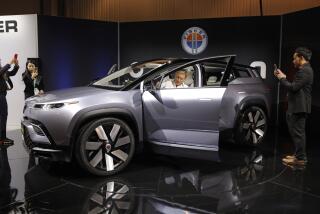Saturn, a Small Car With a Big Mission, Hits the Road
- Share via
SPRING HILL, Tenn. — By its own admission, General Motors Corp. has only one more chance to prove that it can design and build a small car that can compete credibly with the Japanese.
On Thursday, the first shipments of Saturns, the small car carrying those big hopes for GM, left a sprawling new assembly plant here en route to dealers in California and elsewhere.
Saturn is GM’s first new auto division since Chevrolet in 1918. Three versions of the car, a hybrid subcompact-compact with a starting price of $7,995, were displayed by workers who snatched away the vehicles’ covers while their colleagues and state and local dignitaries cheered wildly. The cars were then driven to waiting tractor trailers.
“Ship those cars to California. That’s what we’re here for,” a Saturn executive ordered, referring to the most critical market for the vehicle.
Notably absent from the ceremonies were executives from GM headquarters in Detroit, who deferred to officers of the subsidiary--Saturn Corp.--which the company created five years ago to design the new car from scratch. The public distance GM has maintained from the $3.5-billion project illustrates the marketplace burden that GM’s name has become among buyers of imported cars.
The Saturn leadership itself is a departure from the norm. In what the Saturn “team members” describe as a full-blown system of consensus decision-making, the venture is jointly managed by Saturn President Richard G. (Skip) LeFauve and a United Auto Workers officer, Richard Hoalcraft, who introduced themselves Thursday as “the Skip and Dick show,” to the delight of 2,800 union members looking on.
Whether Saturn can rise above its own cosmic hype, not to mention the formidable competition of about 30 established high-quality small cars, remains to be seen. Also, the car is being launched in an apparent recession accompanied by sharply rising gasoline prices, not the climate a car maker would choose.
The importance of the venture goes beyond GM’s own fortunes. It is also seen as a test of America’s ability to rebound from the beating its manufacturing sector has taken at the hand of foreign competition.
The Saturn officially goes on sale on Oct. 25 to a fledgling group of 30 blue-chip dealers who invested up to $5 million apiece for the privilege of selling nothing but Saturns, although most have separate import franchises. Eight of these early dealers are in California, including five in the Southland. The number of outlets is to reach 130 by spring, building to 800.
Russell Hand, a Toyota, Honda and Ford dealer who will shortly have Saturn dealerships in Torrance and near Los Angeles International Airport, describes interest in the car since an advertising campaign for it began as “extraordinary.”
Seventy callers to a Saturn toll-free number listed obscurely in print ads were referred to him in the last 24 hours alone, he said Thursday. Saturn says 14,000 such calls were received nationally in the last five weeks.
Shortages seem inevitable as the assembly plant increases production more slowly than expected. The company will not say how many cars it is building, but dealers and workers say that UAW members have more than once halted early production out of concern for quality. Donald Hudler, Saturn’s marketing vice president, concedes that there will be “fewer cars than we would like to have” by Oct. 25. He indicated that dealers, whom Saturn prefers to call retailers, would have 30 to 35 cars apiece.
In the past, some car dealers faced with heavy demand have charged whatever the market would bear, angering customers expecting to pay no more than the posted prices. In Saturn’s case, executives concede, the practice would send the wrong signal from a venture that bills itself in its ads as “a different kind of car company.” Hand said: “If a black market doesn’t develop, my inclination is to sell at the sticker price.”
The car itself--a four-door sedan and two-door coupe, to be followed in the next couple of years by a station wagon, convertible and other versions--has generally received good reviews. Test drives suggest that it is above what are perceived to be Detroit’s standards.
“For a first effort, they’ve done a good job,” said Chris Cedergren, analyst at J. D. Power & Associates, the Agoura Hills, Calif., consulting firm whose auto quality surveys have for years documented the inferior quality of domestic cars and, more recently, Detroit’s improvements. Some enthusiasts’ magazines have described Saturn as generally comparable to the better Japanese cars.
In concept, the Saturn venture bears little resemblance to the long trail of wreckage that represents GM’s previous small-car efforts: the Corvairs, Vegas, Citations and sister cars whose notorious problems helped opened the door for Japan’s little-known auto makers to triumph in this country in the 1970s.
GM began working on the project eight years ago, envisioning it from the start as a clean-sheet approach. The project was staffed with volunteers attracted to the idea of cutting through some 80 years’ worth of corporate insularity, acrimonious labor relations and other ills that have made the domestic auto industry vulnerable to foreign competition.
The creation of a separate subsidiary, LeFauve said, gave GM, the union and a few key dealers the legal freedom to write a new labor agreement and overhaul the retail distribution system, thus attacking two of the industry’s most intractable problems.
Saturn then chose the Tennessee hills, after a nationwide bidding war by hundreds of communities, for a massive manufacturing complex that not only assembles the car but casts its aluminum engine blocks and cylinder heads and builds its engine and transmission. This gave Saturn ground-up control over the heart of the car.
The car shares just 2% of its parts with other GM divisions, chief engineer Jay Wetzel said. Everything else was designed exclusively for Saturn, although various GM component manufacturing units supply about 70% of the car.
The size and cost of the project were cut sharply from the $5 billion and 500,000 cars a year first envisioned by recently retired GM Chairman Roger B. Smith, who came up with the Saturn idea. But it is still a massive undertaking, and its scope--when GM already had more plants and less money than it needed--continues to raise doubts in and out of GM.
Some saw it as an indulgence of Smith that drained money from elsewhere in the corporation. The reported delays in certain GM new car projects for the early 1990s, said analyst Daniel Luria of the Industrial Technology Institute in Ann Arbor, Mich., is GM’s way of “making room” for Saturn in the market at the expense of other GM divisions.
“There was a lot of resentment at first, especially at Chevy and Pontiac,” said a mid-level Saturn executive. “But I think that’s subsiding.”
Analyst Maryann Keller, in a 1989 book called “Rude Awakening,” which some company executives privately recommend as a good primer on GM, said progress in quality and labor relations elsewhere in GM--notably at “Buick City” and a joint venture plant with Toyota in Fremont, Calif.--made Saturn “almost redundant.”
But to LeFauve, a career GM engineer, that sounds more like a compliment to GM than a complaint. He said Saturn stands apart from the myriad of joint ventures with Japanese firms that GM and the other U.S. auto firms have entered in to, using Japanese designs and components. Saturn is home-grown.
“Here’s GM out there laying itself on the line and getting beat up for it,” he said. “It’s hard for me to see why. I think GM deserves a hell of a lot of credit. Saturn is an absolute statement by GM that we think there’s need for change.”
The Saturn is aimed at such premier small cars as the subcompact Toyota Corolla and Honda Civic, although in size it straddles the compact and subcompact markets. Those categories of cars account for 4 million sales a year. Saturn hopes to be building 240,000 cars annually within a year, which would put it in the same sales league as Civic and Corolla and make it one of the top 15 selling cars overall.
But the big question is whether those sales are made to current import customers or are simply stolen from other domestic auto companies and, worst of all, from GM itself. Although some “cannibalization” from Chevrolet, Pontiac and other GM divisions is expected, Hudler said the new car won’t be considered a success unless 80% of its sales ultimately come from non-GM customers.
Such inroads are vital to GM, whose future has been slipping away as first-time car buyers opt for other makes. It is bad enough that the company’s share of total U.S. sales has tumbled from 45% to 35% in recent years, but, among those under 45 years of age, GM has dropped to a paltry 25% of sales.
Even GM’s small cars have old owners. The average buyer of a Chevrolet Cavalier, which outsells the Civic and Corolla, is over 50, a Saturn marketing executive noted. Saturn aims at those aged 25 to 45, 60% of whom have gone to college, who make $5,000 to $15,000 more a year than buyers of domestic cars.
Saturn alone is unlikely to dramatically change that picture, nor is it likely to cause sales problems for the Civic and Corolla, market analysts say. More likely, sales will come from what one dealer called the “marginal” imports, such as Isuzu, Subaru, Hyundai, among others, as well as domestic makes.
A case can be made that the actual sales results of Saturn are less important than the deep changes that this project is trying to make in the GM system.
The attempt to create a partnership across Saturn goes beyond the work force to its dealers, who helped create a unique distribution system that gives them large exclusive territories and lets them add their own sales outlets within their market areas as demand warrants. Typically, auto makers add nearby competing franchises when there are sales to justify it.
“It’s a whole new world,” said Mike Smith, vice president and general manager of a Saturn agency in Santa Ana run by megadealer John Campbell III of Irvine, whose GM, Nissan, Ford, Mazda and Porsche franchises generate sales of more than $150 million a year. “Everything Saturn does is different.”
Dealer Hand said that the market-area plan was one of two factors that persuaded him to invest $5 million. The other, he said, “was when I realized just how serious the UAW was about producing quality cars.”
“I never knew a UAW guy before. Now, I’m on a first-name basis with several of them. I’ve been involved at a level in Saturn I never dreamed of. I mean, I sit there and approve the ads with Hudler and a UAW guy. Who’d have thought it?”
The prospect of spreading such fundamental changes throughout GM has led to speculation that the auto maker is prepared to lose money on Saturn almost indefinitely, a notion that was fueled by the car’s unexpectedly low prices. The $7,995 bottom price for a relatively well-equipped version of Saturn won a standing ovation from dealers when it was announced last week.
When asked about profits on the car, analyst Cedergren said, “Who cares? We’ve been criticizing the Big Three for years for being short-term oriented. If 80% of Saturn’s sales are new to GM, I don’t care if it loses money for 30 years, it’s a success.”
Saturn’s executives guffaw at such talk but won’t say when the subsidiary hopes to go in the black.
“As soon as we can get there without screwing everything up,” Hudler said.






